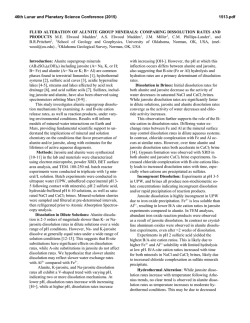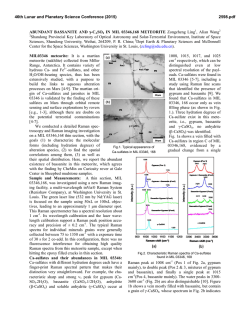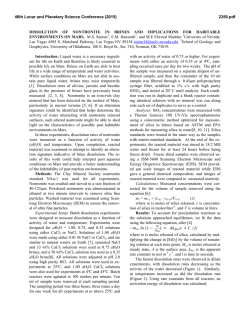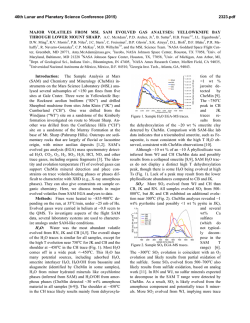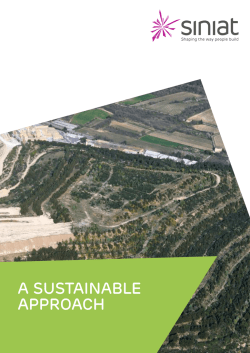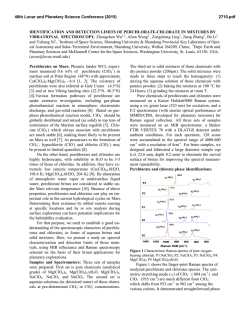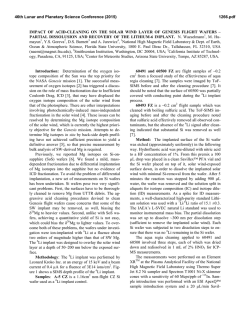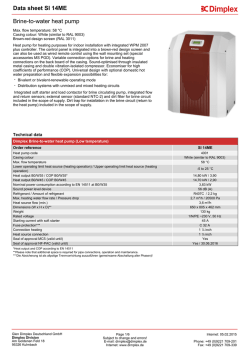
LOW TEMPERATURE ANHYDRITE PRECIPITATION IN FLOWING
46th Lunar and Planetary Science Conference (2015) 1505.pdf LOW TEMPERATURE ANHYDRITE PRECIPITATION IN FLOWING BRINES: IMPLICATIONS FOR CALCIUM SULFATE PHASES OBSERVED ON MARS M.E. Elwood Madden1, E.M. Dixon1, A.S. Elwood Madden1, B.R. Pritchett2, and E.M. Hausrath3. 1School of Geology and Geophysics, University of Oklahoma, Norman, OK, USA, ([email protected]) , 2Oklahoma Geological Survey, Norman, OK, USA 3Department of Geoscience, University of Nevada, Las Vegas, Las Vegas, NV, USA Introduction: Jarosite [KFe3(SO4)2(OH)6] flowthrough dissolution experiments in ultrapure water (UPW), pH 2 sulfuric acid, and saturated NaCl and CaCl2 brines at 295-298 K were conducted to investigate how hydrologic variables may affect jarosite preservation and reaction products on Mars. While hydrologic effects had little influence on jarosite dissolution rates, significant differences were observed in the mineralogy of reaction products. Indeed, anhydrite formed in flowing brine experiments; this is to our knowledge, the first observation of anhydrite precipitation at temperatures < 350 K, suggesting anhydrite can form over short periods of aqueous alteration at Mars near-surface conditions. Methods: Two three-liter reservoirs of experimental solution was set 0.5 m above a Haake Buchler duostaltic pump and two collection, allowing the experiments to be run in duplicate for each experimental solution and flow rate. Synthetic jarosite [1] was placed on a 0.2 µm filter membrane in a polycarbonate filter holder and solution passed through the reactor at a pre-determined flow rate. The solution was collected in a glass beaker every day for three weeks during slow flow rate experiments (0.005 L hr-1). Samples from two UPW short-term experiments conducted at higher flow rates (0.025 and 0.048 L hr-1) were collected over 3 to 5 days to further test the effects of hydrodynamic conditions on jarosite dissolution rates. Each sample was filtered again using a 0.2 µm syringe filter, then acidified and refrigerated in 15 mL tubes at ~277K prior to analysis prior to analysis via Atomic Absorption Spectrophotometry (AAS). As the CaCl2 brine experiments progressed, the flow rate decreased, likely due to the high viscosity of the brine and precipitation of secondary sulfates within the reactor. All other flow-through experiments maintained a steady flow rate. All flow through experiments were conducted at room temperature (295-298 K). Batch Reactor Experiments: Four batch reactor experiments were conducted using the same experimental solutions (UPW, pH 2, NaCl brine, CaCl2 brine) and K-jarosite as the flow-through experiments and sampled over a similar time period in order to directly compare to the flow-through results. Each batch reactor contained 0.1 g of jarosite in 100 mL of solution and was continuously mixed at room temperature (295-298 K). XRD Analysis: Filter papers were removed from the flow-through reactors at the end of each experiment and stored in sealed containers at room temperature to maintain water activity in the sample prior to powder X-Ray diffraction (XRD). The remaining slurry in batch reactor experiments was filtered using the same type of filter paper and also stored in a sealed container at room temperature prior to XRD analysis. Therefore, the only difference between the samples was the nature of the experiment: flowing fluid in a semi-open system or batch reactors in a closed system. Jarosite reaction products were scraped off the 0.2 µm filter paper from the reactor onto a zerobackground slide for powder XRD using a Rigaku Ultima IV X-Ray diffractometer with a Cu tube operated at 40 kV and 44mA and a curved graphite monochromatic that passes predominantly Cu Kα radiation. Data were collected using the Bragg-Brentano method from 2-70˚ 2θ at 0.02˚ step size. Data analysis was completed in MDI Jade (2010) software. Secondary Reaction Products: Goethite was the only iron oxide reaction production observed in the slow flow rate, UPW flow-through experiments and UPW batch dissolution experiments. No iron oxide reaction products were observed in pH 2, NaCl, or CaCl2 flow-through or batch experiments, likely due to high iron solubility at low pH and in chloride-rich solutions. Iron oxide reaction products were also not detected in higher–flow rate dilute flow-through experiments, likely due to colloidal transport of nanoscale iron oxides through the reactor filter, resulting in higher iron concentrations measured in the resulting solutions. Secondary sulfate minerals were observed in both flow-through and batch CaCl2 experiments. These secondary sulfate minerals form as jarosite dissolves and releases sulfate into solution, which combines with calcium from the brine to precipitate low solubility calcium sulfate minerals. While gypsum and minor bassanite were observed in CaCl2 batch experiments in this study, and in previous batch experiments reported in Pritchett et al. [2], anhydrite was the dominant sulfate reaction product observed in both CaCl2 flowthrough reactors, with minor bassanite and gypsum observed in one replicate. To our knowledge, these are the first experiments to produce anhydrite at temperatures below 350K, despite anhydrite being thermody- 46th Lunar and Planetary Science Conference (2015) namically more stable than either gypsum or bassanite in low water-activity brines. These results demonstrate that anhydrite can form during short periods of aqueous alteration in low temperature, high salinity brines. However, formation of anhydrite appears to be kinetically inhibited in stagnant, closed batch-reactor experiments analogous to closed evaporative basins. Instead, anhydrite may require a constant source of low-water activity brine and/or advective solute transport to form at low temperatures. Dissolution Rates: While hydrologic conditions have significant effects on the mineralogy and transport of secondary reaction products, jarosite dissolution rates do not vary significantly with flow rate, indicating that mineral surface reactions control dissolution rates over the range of flow rates investigated. Indeed, in all of the solutions tested, hydrologic variables do not significantly affect extent of jarosite alteration; therefore jarosite is equally likely to be preserved in flowing or stagnant waters on Mars. Instead, differences in solution chemistry have a significant affect on jarosite dissolution rates in both open and closed diagenetic systems, yielding relatively short jarosite lifetimes in saturated CaCl2 brine and at low or high pH. Moderate pH (3-5) dilute solutions resulted in the slowest jarosite dissolution rates and longest particle lifetimes. Implications for Mars: The flow rates employed in these experiments (6 × 10-4 to 5 × 10-3 m s-1) fall within the range of predicted groundwater flow rates (10-6 to 10-2 m s-1) on Mars [3]. However, hydrologic factors appear to have little impact on dissolution rates; therefore jarosite dissolution is likely mineral surface reaction limited. Instead, jarosite dissolution rates, and derived particle lifetimes, are dependent primarily on water chemistry. While variations in hydrologic conditions are not expected to significantly affect jarosite dissolution rates, and hence jarosite preservation, the mineralogy and accumulation of reaction products may be affected by hydrologic variables. Flowing groundwater may flush out nano-scale iron (hydr)oxides, preventing widespread accumulation and also influence the mineralogy of precipitated sulfate secondary products. These experimental results also demonstrate that different calcium sulfate minerals may form in the same high salinity brines under different hydrologic regimes. Most notably, we observed anhydrite formation from flowing aqueous brine at 295-298 K, the first documentation of anhydrite formation from aqueous solution at temperatures <350 K to our knowledge (e.g. [4] which reported anhydrate formation only at T > 350K). Only metastable gypsum and bassanite were observed in closed batch experiments, while open 1505.pdf flowing systems produced the thermodynamically predicted anhydrite [4-6]. These observations require re-evaluation of previous interpretations of calcium sulfate deposits, both with and without jarosite, observed on Mars. Gypsum is the thermodynamically stable calcium sulfate phase at high water activity (dilute aqueous solutions and moderate to high vapor pressures). Observations of metastable gypsum and bassanite formation in lowtemperature batch reactors and closed evaporative basins suggest that gypsum is also the kinetically favored phase in closed diagenetic systems. Therefore, gypsum observed in impact-associated veins within the Shoemaker formation at Meridiani Planum [7] may have formed from fluids that were likely either fairly dilute and/or stagnant. Likewise, extensive polar gypsum deposits [8] may have formed during a wetter period, when dilute fluids were present or within closed pore spaces [9]. Anhydrite is the thermodynamically stable calcium sulfate phase in low water activity brines [5-6] and our experiments demonstrate that anhydrite can form relatively quickly in flowing, aqueous systems at low temperatures. Previous experiments have not produced anhydrite at low temperatures in batch experiments, suggesting anhydrite precipitation is inhibited in closed high salinity systems. Anhydrite, as well as bassanite and gypsum, were reported based on CheMin XRD, Mastcam, and ChemCam analyses in Gale Crater and interpreted as likely forming due to elevated temperatures during burial [10]. However, based on these new experimental results, flowing high salinity fluids should be considered in addition to elevated temperatures and dehydration reactions [10] as a potential mechanism for anhydrite formation in Gale Crater. References: [1] Driscoll R. and Leinze R. (2005) U.S.G.S. Tech. & Meth. 05– D1. [2] Pritchett B.R.. et al. (2012) EPSL, 357-358, 327-336. [3] Luo W., et al. (2011) Geomorphology, 125, 414-420. [4] Ossorio, M. et al. (2014) Chem. Geol., 386, 16-21. [5] Posnjak, E. (1940), Am. J. of Sci. 238, 559-568. [6]Freyer, D. and W. Voigt (2003), Monat. Fur Chemie, 134, 693-719. [7] Squyres, S. W., et al. (2012), Science, 336, 570576.[8] Masse, M et al. (2010) Icarus, 209, 434-451. [9] Niles, P.B., Michalski, J. (2009) Nature Geoscience, 2, 215-220. [10] Vaniman D.T. et al. (2014) Science 343, 6169. Acknowledgements: Funding for this project was provided by NASA grant NNX13AG75G and the School of Geology and Geophysics at the University of Oklahoma.
© Copyright 2026

